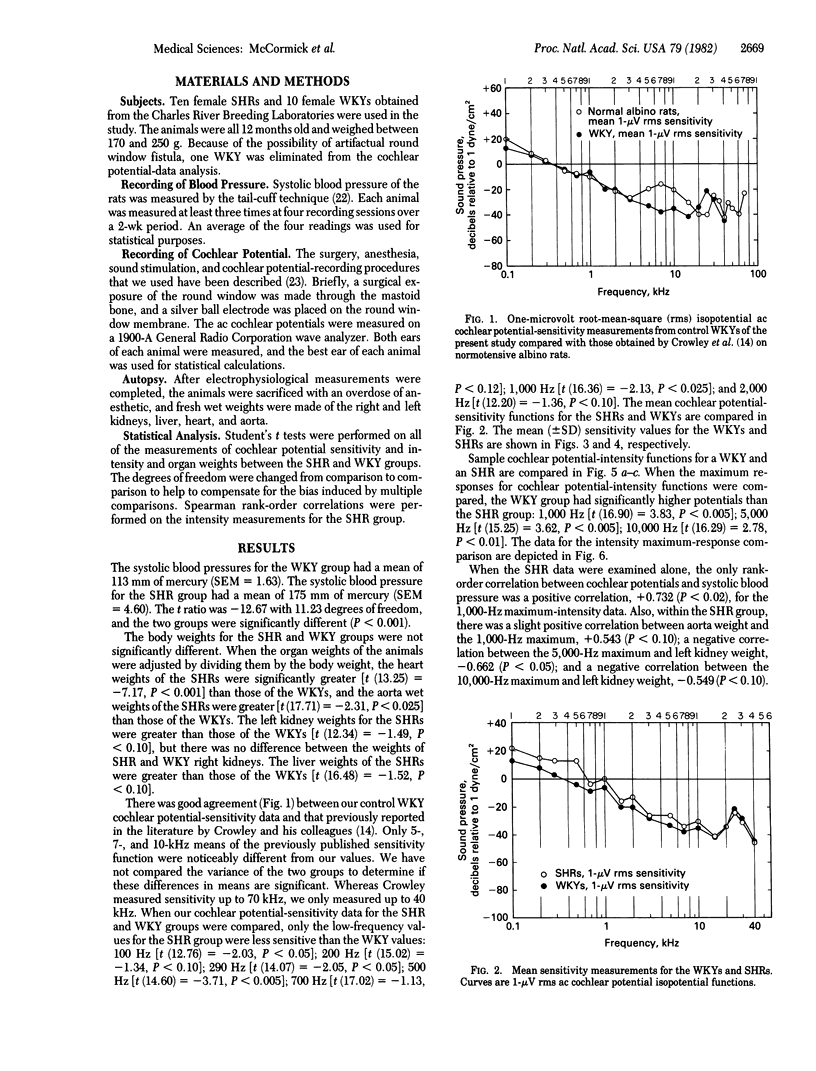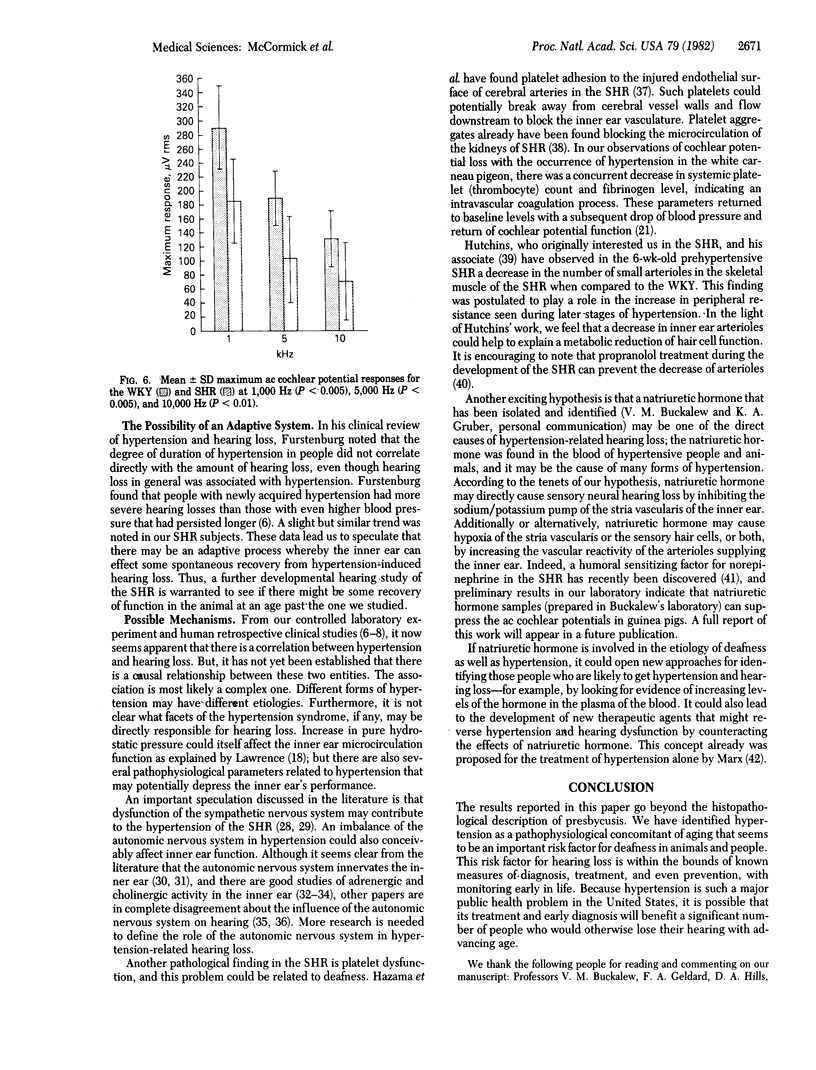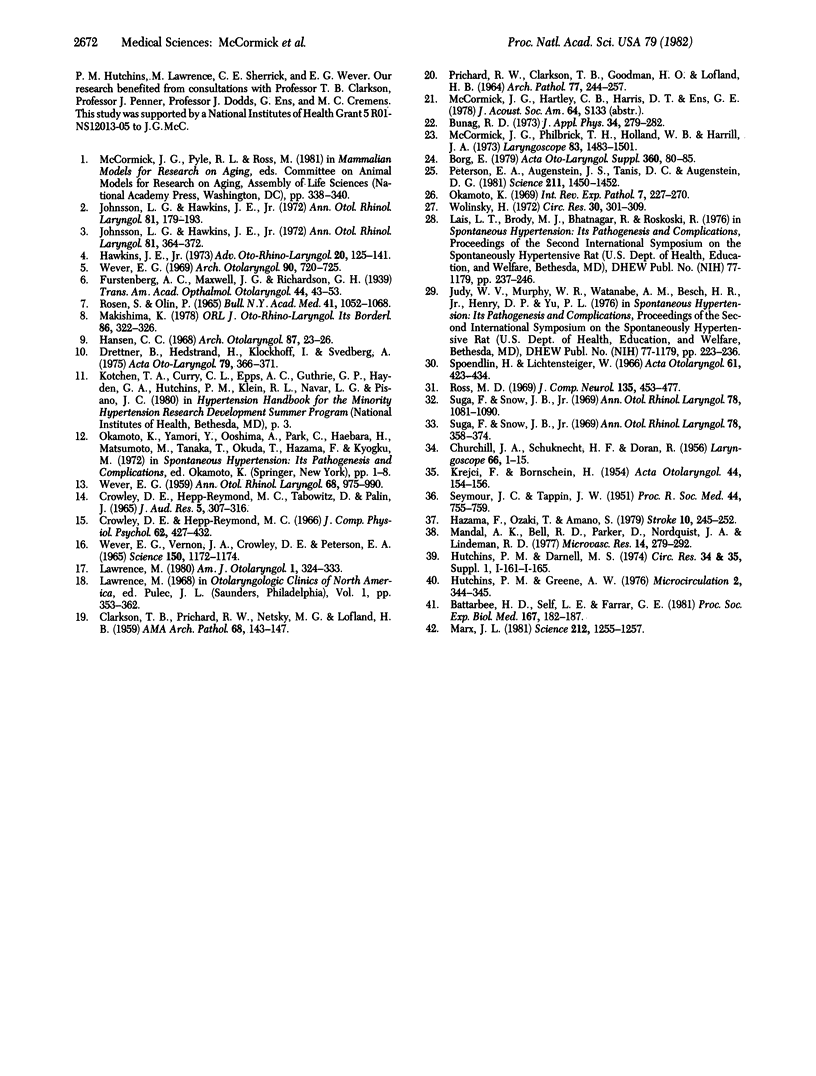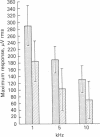Abstract
We present controlled laboratory studies of the spontaneously hypertensive rat which indicate that hypertension is an important pathophysiological risk factor in age-related hearing loss. Our results are in concert with previous retrospective clinical studies that pointed to this possibility in man. Hypertension as a risk factor for hearing loss is within the bounds of known measures of diagnosis, treatment, and even prevention, with monitoring early in life. Because hypertension is such a major public health problem in the United States, in view of our results it is possible that its treatment and early diagnosis will benefit a significant number of people who would otherwise lose their hearing with advancing age. We compared the round window ac cochlear potential-sensitivity and -intensity functions in 10 female spontaneously hypertensive rats and 10 female normotensive Wistar-Kyoto control rats. The animals were all 12 months old and weighed between 170 and 250 g. The normotensives had higher maximum cochlear potential-intensity values compared with the hypertensives: 1,000 Hz (P less than 0.005), 5,000 Hz (P less than 0.005), and 10,000 Hz (P less than 0.01). One-microvolt isopotential cochlear potentials for the low frequencies of the normotensives showed greater sensitivity than those of the hypertensives: 100 Hz (P less than 0.05), 200 Hz (P less than 0.10), 290 Hz (P less than 0.05), and 2,000 Hz (P less than 0.10). Blood pressure of the hypertensive group was significantly greater than that of the normotensive rats (P less than 0.001). The hearts and aortas of the hypertensive group were hypertrophied. Autonomic imbalance, platelet aggregation, decreased arterioles, and natriuretic hormone were discussed as possible etiologies for the measured sensory hearing loss.
Full text
PDF




Images in this article
Selected References
These references are in PubMed. This may not be the complete list of references from this article.
- Battarbee H. D., Self L. E., Farrar G. E. A humoral sensitizing factor for norepinephrine in the spontaneously hypertensive rat. Proc Soc Exp Biol Med. 1981 Jun;167(2):182–187. doi: 10.3181/00379727-167-41146. [DOI] [PubMed] [Google Scholar]
- Borg E. Physiological aspects of the effects of sound on man and animals. Acta Otolaryngol Suppl. 1979;360:80–85. doi: 10.3109/00016487809123480. [DOI] [PubMed] [Google Scholar]
- Buñag R. D. Validation in awake rats of a tail-cuff method for measuring systolic pressure. J Appl Physiol. 1973 Feb;34(2):279–282. doi: 10.1152/jappl.1973.34.2.279. [DOI] [PubMed] [Google Scholar]
- CHURCHILL J. A., SCHUKNECHT H. F., DORAN R. Acetylcholinesterase activity in the cochlea. Laryngoscope. 1956 Jan;66(1):1–15. doi: 10.1288/00005537-195601000-00001. [DOI] [PubMed] [Google Scholar]
- CLARKSON T. B., PRICHARD R. W., NETSKY M. G., LOFLAND H. B. Atherosclerosis in pigeons; its spontaneous occurrence and resemblance to human atherosclerosis. AMA Arch Pathol. 1959 Aug;68(2):143–147. [PubMed] [Google Scholar]
- Drettner B., Hedstrand H., Klockhoff I., Svedberg A. Cardiovascular risk factors and hearing loss. A study of 1,000 fifty-year-old men. Acta Otolaryngol. 1975 May-Jun;79(5-6):366–371. doi: 10.3109/00016487509124698. [DOI] [PubMed] [Google Scholar]
- Hawkins J. E., Jr Comparative otopathology: aging, noise, and ototoxic drugs. Adv Otorhinolaryngol. 1973;20:125–141. doi: 10.1159/000393093. [DOI] [PubMed] [Google Scholar]
- Hazama F., Ozaki T., Amano S. Scanning electron microscopic study of endothelial cells of cerebral arteries from spontaneously hypertensive rats. Stroke. 1979 May-Jun;10(3):245–252. doi: 10.1161/01.str.10.3.245. [DOI] [PubMed] [Google Scholar]
- Johnsson L. G., Hawkins J. E., Jr Sensory and neural degeneration with aging, as seen in microdissections of the human inner ear. Ann Otol Rhinol Laryngol. 1972 Apr;81(2):179–193. doi: 10.1177/000348947208100203. [DOI] [PubMed] [Google Scholar]
- Johnsson L. G., Hawkins J. E., Jr Vascular changes in the human inner ear associated with aging. Ann Otol Rhinol Laryngol. 1972 Jun;81(3):364–376. doi: 10.1177/000348947208100307. [DOI] [PubMed] [Google Scholar]
- KREJCI F., BORNSCHEIN H. The cochlear microphonic potentials during sympathetic stimulation. Acta Otolaryngol. 1954 Mar-Apr;44(2):154–156. doi: 10.3109/00016485409139622. [DOI] [PubMed] [Google Scholar]
- Lawrence M. Control mechanisms of inner ear microcirculation. Am J Otolaryngol. 1980 Aug;1(4):324–333. doi: 10.1016/s0196-0709(80)80035-4. [DOI] [PubMed] [Google Scholar]
- Mandal A. K., Bell R. D., Parker D., Nordquist J. A., Lindeman R. D. An analysis of the relationship of malignant lesions of the kidney to hypertension. Microvasc Res. 1977 Nov;14(3):279–292. doi: 10.1016/0026-2862(77)90026-7. [DOI] [PubMed] [Google Scholar]
- Marx J. L. Natriuretic hormone linked to hypertension. Science. 1981 Jun 12;212(4500):1255–1257. doi: 10.1126/science.6262915. [DOI] [PubMed] [Google Scholar]
- McCormick J. G., Philbrick T., Holland W., Harrill J. A. Diving induced sensori-neural deafness: prophylactic use of heparin and preliminary histopathology results. Laryngoscope. 1973 Sep;83(9):1483–1501. doi: 10.1288/00005537-197309000-00008. [DOI] [PubMed] [Google Scholar]
- Okamoto K. Spontaneous hypertension in rats. Int Rev Exp Pathol. 1969;7:227–270. [PubMed] [Google Scholar]
- PRICHARD R. W., CLARKSON T. B., GOODMAN H. O., LOFLAND H. B. AORTIC ATHEROSCLEROSIS IN PIGEONS AND ITS COMPLICATIONS. Arch Pathol. 1964 Mar;77:244–257. [PubMed] [Google Scholar]
- Peterson E. A., Augenstein J. S., Tanis D. C., Augenstein D. G. Noise raises blood pressure without impairing auditory sensitivity. Science. 1981 Mar 27;211(4489):1450–1452. doi: 10.1126/science.7466404. [DOI] [PubMed] [Google Scholar]
- Rosen S., Olin P. Hearing loss and coronary heart disease. Bull N Y Acad Med. 1965 Oct;41(10):1052–1068. [PMC free article] [PubMed] [Google Scholar]
- Ross M. D. The general visceral efferent component of the eighth cranial nerve. J Comp Neurol. 1969 Apr;135(4):453–478. doi: 10.1002/cne.901350405. [DOI] [PubMed] [Google Scholar]
- SEYMOUR J. C., TAPPIN J. W. The effect of sympathetic stimulation upon the cochlear microphonic potentials. Proc R Soc Med. 1951 Aug;44(8):755–759. doi: 10.1177/003591575104400823. [DOI] [PMC free article] [PubMed] [Google Scholar]
- Spoendlin H., Lichtensteiger W. The adrenergic innervation of the labyrinth. Acta Otolaryngol. 1966 May;61(5):423–434. [PubMed] [Google Scholar]
- Suga F., Snow J. B., Jr Adrenergic control of cochlear blood flow. Ann Otol Rhinol Laryngol. 1969 Apr;78(2):358–374. doi: 10.1177/000348946907800214. [DOI] [PubMed] [Google Scholar]
- Suga F., Snow J. B., Jr Cholinergic control of cochlear blood flow. Ann Otol Rhinol Laryngol. 1969 Oct;78(5):1081–1090. doi: 10.1177/000348946907800514. [DOI] [PubMed] [Google Scholar]
- Wever E. G. Cochlear stimulation and Lempert's mobilization theory. Principles and methods. Arch Otolaryngol. 1969 Dec;90(6):720–725. doi: 10.1001/archotol.1969.00770030722014. [DOI] [PubMed] [Google Scholar]
- Wever E. G., Vernon J. A., Crowley D. E., Peterson E. A. Electrical output of lizard ear: relation to hair-cell population. Science. 1965 Nov 26;150(3700):1172–1174. doi: 10.1126/science.150.3700.1172. [DOI] [PubMed] [Google Scholar]
- Wolinsky H. Long-term effects of hypertension on the rat aortic wall and their relation to concurrent aging changes. Morphological and chemical studies. Circ Res. 1972 Mar;30(3):301–309. doi: 10.1161/01.res.30.3.301. [DOI] [PubMed] [Google Scholar]



